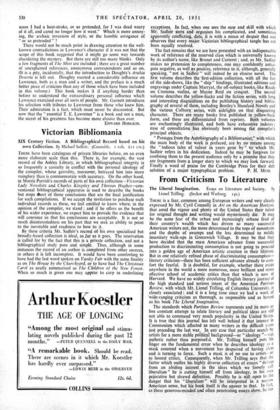Victorian Bibliomania
THERE have been catalogues of private libraries before, on an even more elaborate scale than this. There is, for example, the vast record of the Ashley Library, in which bibliographical integrity is so frequently a casualty in conflict with the personal ideology of the compiler, whose garrulity, moreover, betrayed him into more vainglory than is commensurate with accuracy. On the other hand, in Morris Parrish's records of parts of 'his own collection—Victorian Lady Novelists and Charles Kingsley and Thomas Hughes—con- ventional bibliographical apparatus is used to describe the books but stops Short of those conclusions that are the final justification for such compilations. If we accept the invitation to purchase such individual records as these, we feel entitled to know where, in the opinion of the compiler, we stand ; and if he offers us the benefit of his wider experience, we expect him to provide the evidence that will convince us that his conclusions are acceptable. It is not so much disinterestedness on his part that we seek as ability to point to the inevitable and readiness to bow to it.
By these criteria Mr. Sadldir's record of his own specialised but broadly-based collection is ideal, as .far as it goes. The reservation is 'called for by the fact that this is a private collection, and not a bibliographical study pure and, simple. Thus, although in some instances the record of an author is completed from other sources, in others it is left incomplete. It would have been comforting to have had the last word spoken on Vanity Fair with the same finality as on The House by the Churchyard, or to have had The Christmas Carol as neatly summarised as The Children of the New Forest. When so much is given one may appear to carp in underlining exceptions. In fact, when one sees the ease and skill with which Sadleir sorts and organises his complicated, and sometimes apparently conflicting, data, it is with a moan of despair that one observes that every major Victorian bibliographical tangle has not been equally resolved. The fact remains that. we are here presented with an indispensable work of reference of the reserved class which is universally known by its author's name, like Brunet and Carteret ; and, as Mr. Sadleir makes no pretension to completeness, one may confidently antici- pate negative, as well as positive, reference to.it, although, generally speaking, " not in Sidleir " will indeed be an elusive novel. The first volume describes the'first-edition collection, with all the fun of the side-shows, like the " ship " bindings, illustrated editions and engravings under Captain Marryat, the off-subject books,.like Reade on Cremona violins, or Mayne Reid. on croquet. The second volume describes the yellow-backs and the fiction series, with long and interesting disquisitions on the publishing .history and biblio- graphy of several of them, including Bentley's Standard Novels and the various Colburn- series, with Sidelights on that disquieting Character. There are many books first published in yellow-back form, and these are differentiated from reprints. Both volumes are enchantingly illustrated, and both have exhaustive indexes; ease of consultation: has obviously been. among the compiler's principal objects.
" Passages from the Autobiography of a Bibliomaniac," with which the main body of the work is prefaced, are by ,no" means among the " tedious tales of valour in years gone by " to which Mr. Sadleir refers in his dedication. Indeed he may be forgiven for confining them to the present audience only by a promise that they are fragments from a longer story to which we may look forward. Finally a word of praise for the Cambridge Press for their deft solution of a major typographical problem. P. H. Mum.


































 Previous page
Previous page